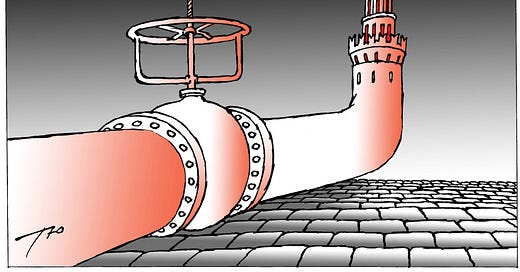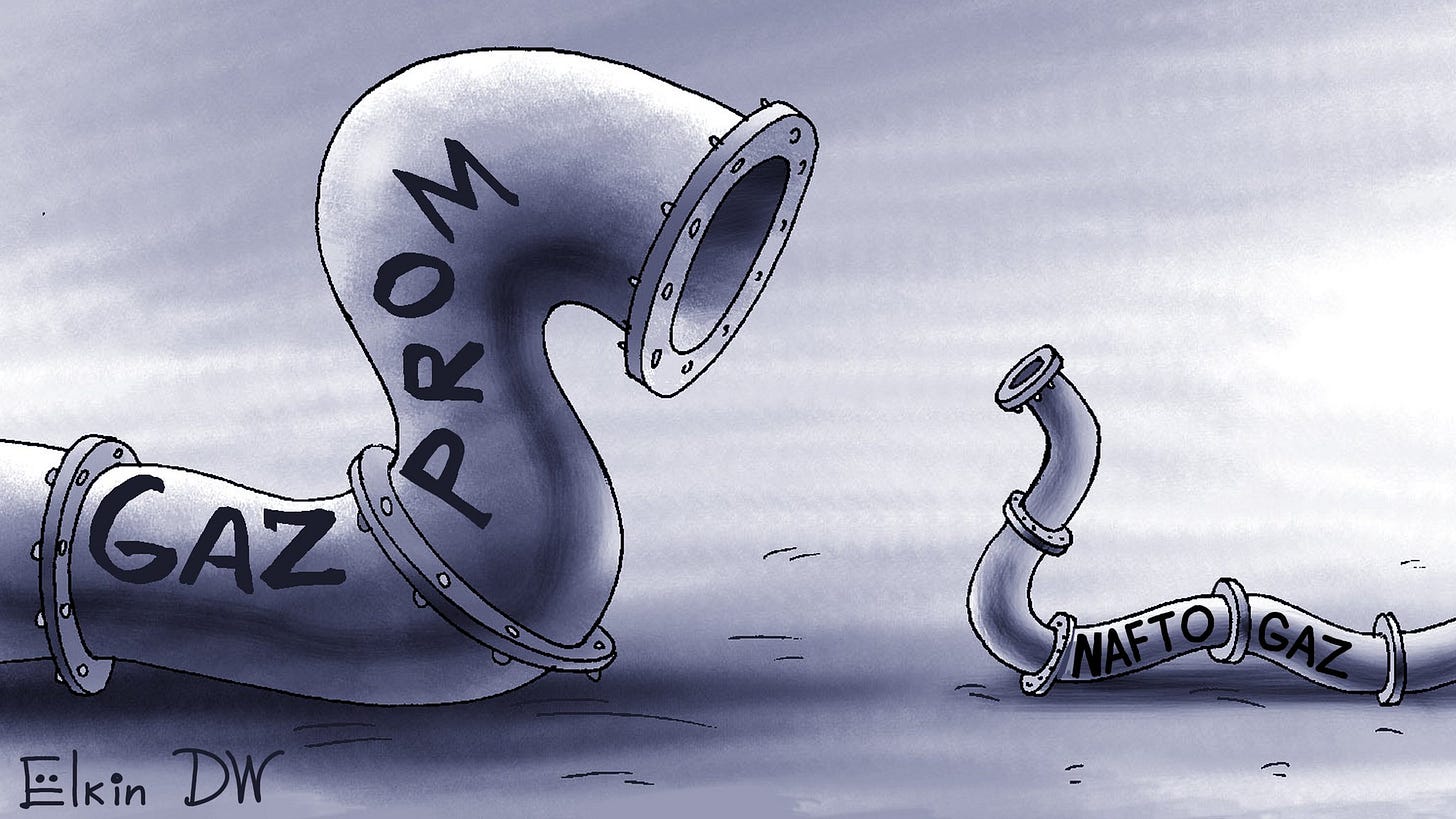September 27, 2022
A strange story
Gas should not go to Europe
Unexpected protest
The Mobilization Mosaic
A strange story
After 10 years of operation, the Nord Stream pipeline from Russia to Germany has ceased operations.
Since last August, the Kremlin has consistently pressured Gazprom to reduce gas deliveries to Europe to destabilize Europe’s economic and political situation. In mid-summer, the amount of gas being pumped through Nord Stream was cut threefold on the pretext that it was impossible to deliver to Russia turbines that were being repaired in Canada. A month ago, the pipeline operation was halted altogether, as a Russian technical inspectorate stated that the operation of the remaining turbines could lead to an accident.
But neither a cut in Russian gas supplies to Europe nor a tenfold increase in gas prices has produced the result the Kremlin had hoped for. And at the same time, holes in the pipes were discovered in three strings of the pipeline—two strings of Nord Stream and a string of Nord Stream 2, prepared but not put into operation—which led to a complete drop in pressure.
The fact that these holes, 75 km one from another, appeared as a result of two roughly equal in might explosions with 5 hours gap between them according to the Danish geological Survey —there has not been a single such case in 10 years of operation—makes us consider the hypothesis of sabotage as the most probable. Conspiracy buffs might suspect the Kremlin, which may be interested in getting European consent to launch Nord Stream 2 at any cost. In a freezing winter, Europe may not have enough of what it will receive under current contracts and lift from underground storage facilities. Then Russia will be the only salvation.
However, it is possible to build a hypothesis about the Russian trace in another way: The new Baltic Pipe pipeline, which will supply gas from Norway to Poland, passes in the same area, and the hypothetical saboteurs could have mixed up the pipes.
One can try to find the interest of Ukraine, which must defend itself against unprovoked aggression from its neighbor, and for which, as they say in Russia, in this war, all means are suitable. Moreover, if suddenly Europe and Russia agree on resuming gas supplies from Siberia, the Ukrainian pipeline will act as an alternative to Nord Stream 2.
You can go even further and look for potential saboteurs among environmentalists, supporters of an early “green transition,” or elsewhere. It remains unclear who was the actual customer and executor of the sabotage. As experts have predicted for a long time, the global energy infrastructure demonstrated its vulnerability and unprotectedness. However, the same can be said about the telecommunications infrastructure.
Gas should not go to Europe
Meanwhile, Gazprom is preparing to deal another blow to European consumers: The company threatened Ukrainian Naftogaz with the possibility of Russian sanctions against it, making it impossible for Gazprom to fulfill its obligations to pump gas through Ukraine. The agreement between Gazprom and Naftogaz was signed for five years in December 2019 and provided for the “pump-or-pay” principle—i.e., the Russian company agreed to pay a minimum amount of Naftogaz services regardless of the actual load of the Ukrainian gas pipeline.
In May, the Ukrainian pipeline operator refused to accept gas through a pipeline’s strings because Russian troops seized a gas distribution station in Luhansk Region with gas volume measuring equipment installed. After that, Naftogaz offered Gazprom to redirect the gas flow to the pipeline’s second string, but the Russian company refused. In June, Naftogaz complained to Gazprom that the payment for gas transit services was less than the contractual minimum. The contract says that the parties must try to settle the dispute by negotiation within 45 days, after which the complaining party has the right to appeal to the court. On September 9, Naftogaz filed a claim with the International Court of Arbitration at the International Chamber of Commerce and Industry in Paris. Today Gazprom issued a statement in which it first accused Naftogaz of failing to fulfill the contract terms, then announced its distrust of the arbitration court, and, finally, threatened Naftogaz with sanctions, considering the appeal to the court “an unfriendly step and bad faith behavior.” Russian sanctions against Naftogaz “will mean a ban for Gazprom to fulfill its obligations to the sanctioned persons on the deals made.”
Unexpected protest
The Russian Union of Industrialists and Entrepreneurs (RSPP), an association of big business, accused the Russian government of “violating the principles of social partnership” and, straight out, of fraud.
The RSPP asserts that the government has approved the draft Social fund1 budget for 2023 with modified tax conditions without discussing them at the Trilateral Commission with the participation of business associations and labor unions.
Russia uses a regressive scale of contributions to the Social Fund: 30% up to an annual salary of 1.565 million rubles and 15.1% on the portion of the wages above that limit. After the government approved the Social Fund’s draft budget, RSPP experts discovered that the salary cap for calculating the budget had been raised by 22.5%, significantly higher than the rate of wage growth in the economy.
The adjustments to the social insurance system came as a surprise, contradicting the agreements reached during the consideration of the law on the fund and the unified insurance contribution. Initially, the payroll burden was expected to increase only slightly, businessmen stated. The government has not yet responded to the claims made, but I doubt that the Finance Ministry will give a reversal. Traditionally, the Social Fund budget comes with a deficit financed by a transfer from the federal budget. To meet the businessmen’s complaint means to increase budget expenditures and rock its structure even more. This is hardly part of the government’s plans.
The petty cheating by the Ministry of Finance and the Labor Ministry, which prepared the budget of the Social Fund, does not surprise me. But the loud public accusation from the Russian Union of Industrialists and Entrepreneurs goes way beyond the framework of the relations between the government and business in Russia.
The Mobilization Mosaic
Mobilization remains a central topic in Russia, and the content of the discussion does not change: Chaos and the flight of young Russians from the country continue.
Numerous videos appearing on social media describe the living conditions of the mobilized. As a rule, there are dozens of beds in the sleeping quarters and often no mattresses, blankets, or pillows, let alone linens. At the same time, there are no complaints about food quality. In many locations, the mobilized people received bank cards and were promised they would receive their first salaries on October 10.
The Russian authorities, faced with mass criticism of their actions, decided to lead the fight “against excesses on the ground”: Kremlin propagandists began actively criticizing local leaders for violating mobilization conditions. The military commissar of the Magadan region was dismissed as a show of flogging.
However, the hunt for potential servicemen does not stop; although officially, the exit from Russia is not closed (that can be done only under martial law), reports periodically appear that young men are refused to be registered for air flights, both international and domestic.
At the Russian-Georgian border, where the Upper Lars border crossing is the tensest, with enormous traffic jams, Russian military personnel has been stationed “to reduce the risks of illegal behavior and conflict situations.”
The influx of light vehicles traveling toward Georgia is seriously increasing. To reduce the risk of unlawful conduct and conflict situations, it has been decided to allow citizens to cross the border on foot.
North Ossetian authorities announced that a mobilization point will soon be opened on the territory of Upper Lars, and it is expected that those wishing to cross the border will receive military summonses as soon as they present their passports.
The Migration Service of Kazakhstan reported that about 98,000 Russian citizens entered Kazakhstan while 64,000 moved in the opposite direction within six days after the announcement of mobilization in Russia. This number is twice the average weekly level of the third quarter for 2017-2019.
Georgia’s Ministry of interiors published its data: from September 23 to 26, about 15,000 more Russians left Russia than returned to there country.
In Kazakhstan’s regions bordering Russia, residential rents went up from 15% to 34%, according to Kazakhstan’s real estate website Krisha (Roof).
The increase in cost mainly occurred over the weekend and was due to an increase in rental demand. The most in-demand cities, judging by user requests, are Uralsk, Aktobe, Kostanay, Petropavlovsk, Pavlodar.
Pension, Social Security, and medical Security funds have been combined into one entity since 2023.







